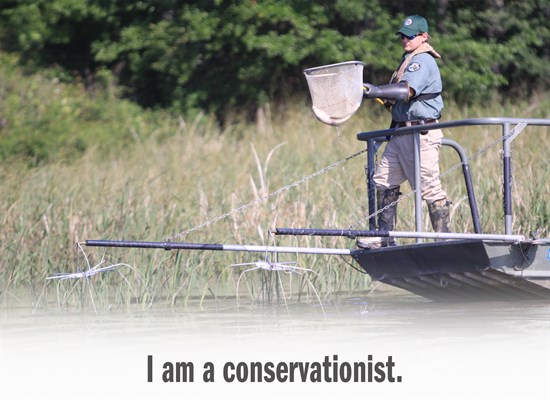
WHAT IS THE ROLE OF THE FISHERIES BUREAU IN CONSERVATION?
The Fisheries Bureau is responsible for managing and protecting fish populations and their habitat in the public waters of Mississippi. This effort encompasses approximately 120 lakes and 123,750 miles of streams throughout the state. The Fisheries Bureau is also charged with providing recreational facilities and opportunities for anglers and boaters. In addition, fisheries biologists provide technical pond management advice to private landowners and conduct educational and outreach programs that promote and encourage fishing and fisheries conservation.
The Fisheries Bureau accomplishes our conservation objectives by addressing the three central themes of the MDWFP mission:
I. CONSERVE AND ENHANCE MISSISSIPPI'S WILDLIFE, FISHERIES, AND PARKS
Fisheries Management and Research
Fisheries biologists identify fisheries management needs and develop management plans that include regulations to enhance and manage fish populations in large waterbodies. These management plans provide a guide for sampling fish populations and conducting angler creel surveys. These results are used when necessary to revise rules and harvest regulations. For example, recent angler creel surveys completed at Grenada Reservoir indicated that the number of anglers fishing for crappie increased by 400% from 1997 to 2005. These creel surveys also suggested that crappie anglers using trolling methods caught more fish. These findings, when combined with biological data about crappie populations, resulted in reducing the daily creel limit, instituting a larger minimum length limit, and restricting the number of fishing poles that may be used by crappie anglers. These rule changes were adopted by the Commission on Wildlife, Fisheries, and Parks to manage the trophy crappie fishery that exists at Grenada Reservoir.
Fisheries biologists also improve fish habitat in lakes and streams. Recently, biologists worked with the U.S. Fish and Wildlife Service to enhance Walleye spawning habitat in Mackey's Creek in Prentiss County by stabilizing the creek bank and adding gravel substrate. The MDWFP also received a grant from the Southeast Aquatic Resources Partnership and partnered with Wilkinson County to replace the old weir at Lake Mary. The new weir structure keeps water levels higher, which improves fisheries habitat and access to the lake for anglers and boaters. Biologists are also managing invasive aquatic plants through the application of selective aquatic herbicides in waters like Crystal Lake near Flowood, MS.
In addition to managing public waters, fisheries biologists provide technical pond management advice to private landowners.
Fisheries biologists serve on conservation committees that provide advisement and guidance to other conservation organizations or professional groups such as:
Southern Division of the American Fisheries Society
Lower Mississippi River Conservation Committee
Mississippi Department of Environmental Quality river basin teams
Southeast Aquatic Resources Partnership
II. PROVIDE QUALITY OUTDOOR RECREATION
State Fishing Lakes
The Fisheries Bureau maintains and enhances 18 state-owned lakes and adjacent lands to provide fishing, boating, and camping opportunities for the general public. The goal is to provide quality fishing opportunities and safe facilities such as fishing piers, boat ramps, restrooms, camping areas, and pavilions for all visitors. Fisheries biologists also manage the 20 lakes located at our State Parks.
Community Assistance Program
The Fisheries Bureau partners with counties, cities, and private groups to manage small lakes and ponds through the Community Assistance Program. The goal of this program is to enhance the management and development of lakes and ponds in urban settings so that local residents, especially youth, will be able to experience the joys of fishing close to home.
State Fish Hatcheries
The Fisheries Bureau operates two fish hatcheries totaling 29 surface acres of water: Turcotte Hatchery near Canton, and the North Mississippi Fish Hatchery near Enid. Hatchery-raised fish are stocked to enhance or restore fish populations in many public waters. Important species produced at the hatcheries are the Florida-strain Largemouth Bass, Striped and hybrid Striped Bass, Southern-strain Walleye, Crappie (including the Magnolia crappie - a triploid hybrid produced only in Mississippi), and Bluegill and Redear Sunfish. Channel Catfish, Flathead Catfish, and Grass Carp are also produced. Recent culture efforts have included Paddlefish and Alligator Gar.
Fish from these hatcheries are stocked throughout the state. When the Fisheries Bureau drains and renovates a state fishing lake, like recently at Lake Lamar Bruce in Lee County, Channel Catfish, Bluegill, Redear Sunfish, and Largemouth Bass are stocked to replenish the fish populations and provide fishing opportunities for lake users. Florida Largemouth Bass are stocked into many water bodies to enhance the native bass populations. Since 2012, over 1 million Florida Largemouth Bass have been stocked into public waters. Lakes that receive bass include Ross Barnett Reservoir, lakes within the Tennessee Tombigbee Waterway, Eagle Lake, and some of the State Fishing Lakes. After the 2011 fish kill in the lower Pearl River, MDWFP hatcheries produced and stocked over 71,000 fish. Species stocked included Blue and Channel Catfish, Largemouth Bass, and White Crappie.
Boating Access Project
Fisheries personnel work with local governments across the state to construct and maintain boating access facilities and fishing piers on public waters across the state. Recently completed projects include new boat ramps on Red Creek in Stone County, the Pearl River in Marion County, the Mississippi River at Greenville and Ross Barnett Reservoir in Rankin County. Three boat ramps on the Mississippi River were extended during recent low river stages, and improvements to Moon Lake Park Landing in Coahoma County included extending and paving the parking lot and road, and constructing a new pavilion and fish cleaning station.
Fishing Rodeo Program
The Fishing Rodeo Program annually provides fish and fishing instruction to over 5,000 youth at 45 - 60 children's fishing events throughout the state. These events afford fishing opportunities in a safe environment where the probability of catching a fish is greatly increased by fish stockings.
III. ENGAGE THE PUBLIC IN NATURAL RESOURCE CONSERVATION
Through field days, workshops, speaking engagements, reports, popular articles, technical publications, radio and television, websites, and other media, the MDWFP's Fisheries Bureau imparts a deeper understanding and appreciation of Mississippi's fisheries, their management, and the challenges they face, to all Mississippi's citizens.









